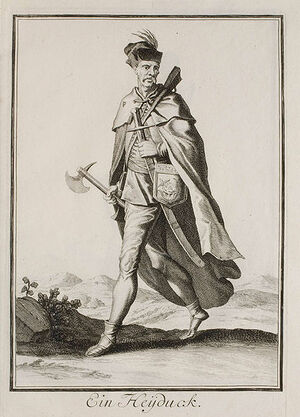Brandishing (nonfiction): Difference between revisions
(Created page with "File:432px-Welt-Galleria_T063.jpg|thumb|Hajduk, 1703, prominently displaying a wicked-looking one-handed axe-and-pick weapon. Some scholars believe that this is [[The Brandi...") |
No edit summary |
||
| Line 1: | Line 1: | ||
[[File:432px-Welt-Galleria_T063.jpg|thumb|Hajduk, 1703, prominently displaying a wicked-looking one-handed axe-and-pick weapon. Some scholars believe that this is [[The Brandisher]] himself; others argue that the image is a forgery and a calumny.]]'''Brandishing''' is displaying a [[weapon]] in order to intimidate another person. | [[File:432px-Welt-Galleria_T063.jpg|thumb|Hajduk, 1703, prominently displaying a wicked-looking one-handed axe-and-pick weapon. Some scholars believe that this is [[The Brandisher]] himself; others argue that the image is a forgery and a calumny.]]'''Brandishing''' is displaying a [[weapon]] in order to intimidate another person. | ||
== Etymology == | |||
brand (n.) | |||
Old English brand, brond "fire, flame; firebrand, piece of burning wood, torch," and (poetic) "sword," from Proto-Germanic *brandaz (source also of Old Norse brandr, Old High German brant, Old Frisian brond "firebrand, blade of a sword," German brand "fire"), from root *bran-/*bren- (see burn (v.)). | |||
* Meaning "identifying mark made by a hot iron" (1550s) | |||
* Broadened by 1827 to "a particular make of goods." | |||
* Brand name is from 1922. | |||
brand (v.) | |||
* c. 1400, "to brand, cauterize; stigmatize," originally of criminal marks or cauterized wounds, from brand (n.). | |||
* As a means of marking property, 1580s; | |||
* Figuratively from c. 1600, often in a bad sense, with the criminal marking in mind. Related: Branded; branding. | |||
Source: http://www.etymonline.com/index.php?term=brand | |||
== US Federal definition == | == US Federal definition == | ||
Revision as of 06:08, 31 May 2016

Brandishing is displaying a weapon in order to intimidate another person.
Etymology
brand (n.)
Old English brand, brond "fire, flame; firebrand, piece of burning wood, torch," and (poetic) "sword," from Proto-Germanic *brandaz (source also of Old Norse brandr, Old High German brant, Old Frisian brond "firebrand, blade of a sword," German brand "fire"), from root *bran-/*bren- (see burn (v.)).
- Meaning "identifying mark made by a hot iron" (1550s)
- Broadened by 1827 to "a particular make of goods."
- Brand name is from 1922.
brand (v.)
- c. 1400, "to brand, cauterize; stigmatize," originally of criminal marks or cauterized wounds, from brand (n.).
- As a means of marking property, 1580s;
- Figuratively from c. 1600, often in a bad sense, with the criminal marking in mind. Related: Branded; branding.
Source: http://www.etymonline.com/index.php?term=brand
US Federal definition
According to United States Sentencing Commission Guidelines:
(C) "Brandished" with reference to a dangerous weapon (including a firearm) means that all or part of the weapon was displayed, or the presence of the weapon was otherwise made known to another person, in order to intimidate that person, regardless of whether the weapon was directly visible to that person. Accordingly, although the dangerous weapon does not have to be directly visible, the weapon must be present.